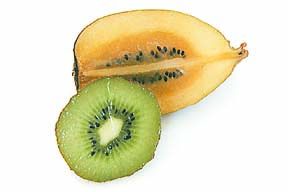
Eleanor Nakama-Mitsunaga

|
For those who enjoy kiwi fruit, there's a new, even better, variety that's now in season. Gold kiwi is a vibrant yellow fruit that differs not only in color from the standard green kiwi, but also in taste. Its sweet tropical flavor resembles that of mango and pineapple.The basics: Kiwi fruit originated in China, where hundreds of varieties of this vine-like plant grow wild. The fruit was traditionally known as Chinese gooseberry, before Chinese missionaries introduced it to New Zealand. There it got the name kiwi, after the indigenous fuzzy brown bird.
The kiwi is a rather odd-looking egg-shaped fruit. It has a hairy brown skin that needs to be removed. Inside, the flesh has traditionally been green, with a center ring of black seeds, however, a new yellow-fleshed fruit made its appearance in the United States in 2000.
The gold kiwi has a smoother outer skin and a hard pointed nub at one end, which also distinguishes it from the green version. Kiwis are a good source of vitamins C and E.
Selecting: Look for fruit that is large and plump. Kiwis should be firm, giving slightly to pressure. If too firm, they should be left out on the counter a day or two until they yield to slight pressure. Avoid fruit that is wrinkled or too soft.
Storing: Ripe fruit can be stored in the refrigerator for a week or two unpeeled. Peeled fruit is highly perishable and may keep only for a couple of days.
Use: The easiest way to remove the outer skin is to cut the kiwi in half and scoop out the flesh with a spoon. The flesh should release easily. The fruit can then be eaten out of hand or cut up for fruit salads. Slices may be arranged on top of a fruit tart.
Kiwis can also be blended with other fruits in a smoothie or sliced and served in a beautifully arranged platter of melons, pineapple and various berries.
Where to buy: Kiwi fruit is available year-round, but the gold variety is only available from June through September. Many supermarkets are now stocked with both varieties at 50 to 80 cents per fruit.
Eleanor Nakama-Mitsunaga is
a free-lance food writer. Contact her
online through features@starbulletin.com

